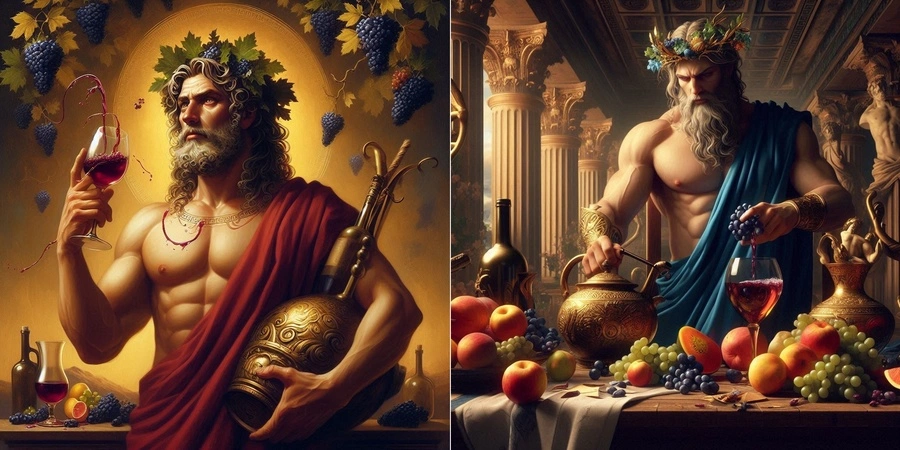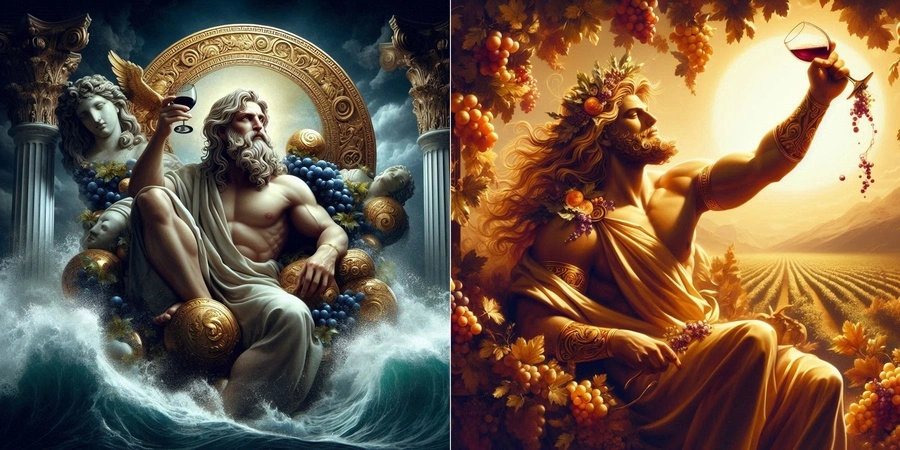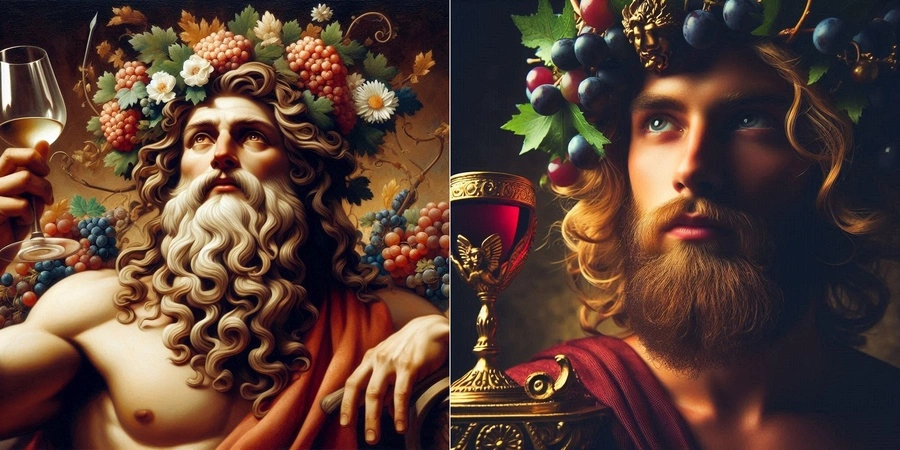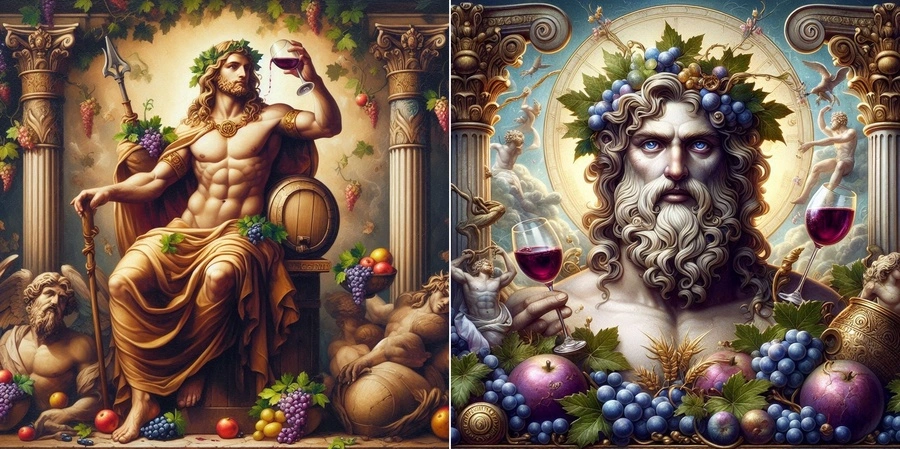
Dionysus, the Greek god of wine, fertility, and ecstasy, was one of the most fascinating and enigmatic deities in ancient Greek mythology. He is often depicted as a wild and unpredictable figure, embodying the chaotic and transformative powers of nature.
Dionysus is one of the twelve Olympian gods and goddesses, and he was highly revered in ancient Greece. He was known for his wild and extravagant nature, and was often associated with wine, theater, and dance.
The Story of Dionysus
Dionysus’ origins are shrouded in mystery. Unlike most Olympian gods, his birth was fraught with danger. His mother, Semele, a mortal princess, dared to bear the child of Zeus, king of the gods. However, Zeus’ wife, Hera, consumed by jealousy, tricked Semele into demanding to see Zeus in his full godly glory. The overwhelming brilliance incinerated Semele, but Zeus managed to save the unborn Dionysus by sewing him into his thigh until he reached full term. This unconventional birth imbued Dionysus with a unique connection to both the divine and the mortal realms.
Fearing Hera’s wrath, Zeus entrusted Dionysus to the care of nymphs who raised him in a hidden grove. There, amidst the lush vegetation and untamed wilderness, Dionysus discovered the secrets of viticulture – the cultivation of grapes and the production of wine. Wine, for the Greeks, was more than just an intoxicating beverage; it was a divine gift, a symbol of fertility and festivity. Dionysus, the god who emerged from the wild and nurtured by its bounty, became its natural patron.
As Dionysus matured, he embarked on a journey across the world, spreading the knowledge of winemaking and igniting a passion for ecstatic revelry. His retinue, known as the Maenads and Satyrs, embodied the untamed spirit of his domain. The Maenads, female followers adorned with grapevines and wild beasts’ skins, danced themselves into a state of ecstatic frenzy, their inhibitions dissolving under the influence of wine. The Satyrs, half-man, half-goat creatures, personified the untamed, playful aspects of nature.
Dionysus’ cult, unlike the structured rituals dedicated to other deities, was characterized by wild abandon and uninhibited celebration. His festivals, known as Dionysia, were marked by music, dance, and theatrical performances. Wine flowed freely, and participants, shedding social constraints, revelled in a state of ecstatic madness. This “divine madness,” as it was called, allowed for a temporary release from the rigidities of everyday life and a connection to a primal, untamed energy.

Family of Dionysus
Dionysus’ most well-known consort is Ariadne, the daughter of King Minos of Crete. Abandoned by the hero Theseus on the island of Naxos, Ariadne was discovered and wed by Dionysus. Their union is depicted as one of love and harmony, a notable deviation from the often tumultuous relationships between gods and mortals.
- Oenopion: Oenopion, whose name means “wine-drinker,” is one of the sons of Dionysus and Ariadne. He became a legendary king and was known for his skill in winemaking, a clear reflection of his divine father’s domain. Oenopion ruled over the island of Chios and was reputed to have introduced grape cultivation and wine production there. His story also intersects with that of the giant Orion, whom Oenopion blinded after the latter attempted to assault his daughter, Merope.
- Thoas: Thoas, another son of Dionysus and Ariadne, is known for his role in the mythology of the Argonauts. He became the king of Lemnos, an island that played a significant part in various Greek myths. Thoas’ reign on Lemnos was marked by the island’s infamous episode where the women, led by his daughter Hypsipyle, killed all the men except him. Hypsipyle saved her father by hiding him and later helped him escape.
- Staphylus: Staphylus, whose name translates to “grape cluster,” further embodies the vinous heritage of Dionysus. He was also a king and is sometimes credited with discovering the art of making wine, reinforcing his father’s legacy in viticulture. Staphylus’ influence extended to the island of Peparethos (modern-day Skopelos), known for its wine production.
- Euanthes: Euanthes, another son, is less prominently featured in myths but still contributes to the Dionysian lineage. His name means “blooming” or “flowering,” which could symbolize the flourishing of the vine and the intoxicating beauty of wine, traits associated with Dionysus.
Other Offspring
Dionysus’ amorous escapades weren’t limited to Ariadne. He had several other consorts, both mortal and divine, leading to more offspring who inherited various aspects of his power and influence.
- Priapus: Priapus, a god of fertility, livestock, fruit, gardens, and male genitalia, is often considered a son of Dionysus and Aphrodite. Known for his exaggerated phallic symbol, Priapus was a protector of horticulture and a symbol of male fertility. His myth reflects the fertility aspect of Dionysus, showing how his offspring continued his father’s themes in different domains.
- Phthonus: Phthonus, the personification of envy and jealousy, is sometimes listed as a son of Dionysus and Nyx (Night) or Aphrodite. His presence in myths underscores the duality of Dionysus’ nature—while wine brings joy and ecstasy, it can also incite jealousy and discord.
- Deianira: Deianira, not to be confused with Heracles’ wife of the same name, is occasionally cited as a daughter of Dionysus. Her story is less prominent, but her connection to Dionysus suggests the widespread influence of his lineage.

10 Myths and Facts About Dionysus
- The Pirates and the Vine: One myth tells of Dionysus being captured by pirates while disguised as a mortal. The pirates planned to sell him into slavery, but as they sailed away, miraculous things began to happen. Vines spread across the ship, and wild animals appeared, frightening the pirates. Dionysus revealed his true form, driving the pirates mad and turning them into dolphins. This myth underscores his divine power and his ability to transform and punish those who wrong him.
- Dionysus and King Midas: Dionysus once granted King Midas a wish for his kindness in helping the god’s old tutor, Silenus. Midas wished that everything he touched would turn to gold. However, this gift quickly became a curse, as even food and drink turned to gold. Realizing his mistake, Midas begged Dionysus to take back the gift. Dionysus instructed him to wash in the river Pactolus, which removed the golden touch and left the river’s sands rich with gold. This myth illustrates the dual nature of Dionysus’ gifts and the consequences of human greed.
- The Thyrsus: A distinctive attribute of Dionysus is the thyrsus, a staff wound with ivy and topped with a pinecone. The thyrsus symbolizes prosperity, fertility, and the god’s intoxicating power. In myths, the thyrsus could be a weapon, capable of striking enemies with madness or death. The thyrsus exemplifies Dionysus’ role as a deity of both life and death, embodying growth and destruction.
- The Bacchae and Ritual Madness: The Bacchae, or Maenads, were female followers of Dionysus known for their ecstatic and frenzied worship. They roamed the forests, dressed in fawn skins, and carried the thyrsus. In their trance-like states, they possessed superhuman strength and were often depicted tearing animals apart in their wild rituals. This myth highlights Dionysus’ ability to inspire divine madness and break down societal norms.
- Dionysus’ Role in the Underworld: Dionysus is one of the few gods who ventured into the Underworld and returned. He descended to retrieve his mother, Semele, and brought her to Mount Olympus, where she was made immortal. This journey symbolizes Dionysus’ connection to life, death, and rebirth, aligning him with seasonal cycles and the regeneration of nature.
- The Transformation of Ampelos: Ampelos was a satyr and a lover of Dionysus. Tragically, Ampelos died in an accident, but Dionysus transformed him into the first grapevine, thus creating wine. This myth represents the origin of wine and its deep connection to Dionysus, illustrating themes of love, loss, and transformation.
- Dionysus and the Theatre: Dionysus is not only the god of wine but also of theater and dramatic arts. The Great Dionysia, a festival in Athens, celebrated him with performances of tragedies and comedies. This association highlights his influence on culture and the arts, emphasizing the connection between ecstasy, performance, and storytelling.
- The Birth of Zagreus: In Orphic tradition, Dionysus is sometimes identified with Zagreus, a son of Zeus and Persephone. Hera, in her jealousy, had the Titans dismember Zagreus, but Athena saved his heart. Zeus consumed the heart, and Dionysus was reborn. This myth of death and rebirth underscores Dionysus’ role in the cycle of life and the continuity of the soul.
- Dionysus and the Nymphs: After his birth from Zeus’ thigh, Dionysus was raised by nymphs on Mount Nysa. These nurturing figures protected and taught him, contributing to his divine education. This upbringing by the nymphs symbolizes his deep connection to nature and the wild, uncontrollable aspects of his character.
- The Miracle at the Wedding of Dionysus and Ariadne: At the wedding of Dionysus and Ariadne, it is said that vines grew spontaneously, and wine flowed like rivers. This miraculous event symbolizes the union of the divine and mortal, and the blessings of abundance and fertility that Dionysus brings. It also underscores the joy and prosperity associated with his presence.

The Symbols of Dionysus
One of the most well-known symbols of Dionysus is the grapevine. Grapes were a central part of ancient Greek culture, and wine was often associated with both the divine and the profane. The grapevine symbolizes Dionysus’s connection to the natural world and his ability to transform the ordinary into the extraordinary. The grapevine also represents the cycles of life and death, as the fruit must be harvested and crushed in order to produce wine.
Another important symbol of Dionysus is the thyrsus, a wand or staff topped with a pinecone. The thyrsus was an important attribute of Dionysus’s followers, and it was often used in ritual dances and celebrations. The pinecone is believed to represent the power of transformation and regeneration, and it is often seen as a symbol of the god’s ability to bring about both chaos and rebirth.
Dionysus is often depicted wearing a crown of ivy leaves or leopard skin. These symbols represent his connection to the natural world and his ability to move between different states of being. The ivy leaves symbolize Dionysus’s connection to both wine and the wild, while the leopard skin represents his power and his ability to transcend human limitations.
Frequently Asked Questions
What is Dionysus’ Roman name?
Dionysus’ Roman name is Bacchus. While the Greeks and Romans shared many deities, they often used different names for them. Bacchus captured the more celebratory and boisterous aspects of Dionysus, often associated with drinking parties and revelry.
Why was Dionysus punished?
Dionysus was punished in various myths for different reasons, often tied to his unconventional birth and his disruptive influence. In one myth, Hera, jealous of his existence, drove him mad, causing him to wander the earth. In another story, King Pentheus of Thebes punished Dionysus and his followers for their ecstatic worship practices, only to face dire consequences himself. These punishments often reflect the tension between Dionysus’ wild, unrestrained nature and societal norms.
what does Dionysus look like?
Dionysus’ appearance was interesting and evolved over time in Greek art:
- Early Depictions: In older portrayals, Dionysus was depicted as a bearded man, sometimes even with a somewhat stern expression. This reflected a more serious and powerful aspect of his godhood, associated with fertility and nature’s bounty.
- Later Portrayals: As his cult gained popularity, Dionysus’ image shifted towards a more youthful and effeminate figure. He was often depicted with long, flowing hair, adorned with a crown of ivy or grapevines. This shift emphasized his association with revelry, festivity, and the liberating aspects of wine.
- Varying Attributes: Across depictions, some key elements remained constant. He was frequently shown carrying a thyrsus, a staff topped with a pine cone and wrapped with ivy. This staff symbolized his power and connection to nature. He might also be depicted holding a kantharos, a large two-handled cup used for drinking wine.
What are Dionysus powers?
- Power of Wine: This might seem obvious, but it’s central to his identity. Dionysus wasn’t just the god of enjoying wine; he held the power to create it and influence its effects. He could induce states of ecstatic joy, intoxication, and even madness through wine.
- Inspiring Frenzy: Dionysus had the ability to invoke a state of “theia mania” or “divine madness” in his followers. This wasn’t a negative state, but rather a controlled frenzy that allowed participants in his festivals to shed inhibitions and connect with a primal energy.
- Transformation: Some myths depict Dionysus possessing the ability to transform himself or others. He could assume the form of animals like a bull or a lion, reflecting his connection to the wild.
- Nature’s Bounty: As a god associated with fertility and vegetation, Dionysus had an influence over the growth of plants, particularly grapevines. He could ensure bountiful harvests and symbolize the life-giving power of nature.
- Blurring Boundaries: Dionysus’ unconventional birth and association with both the civilized and wild aspects of life blurred the lines between different realms. He could navigate the underworld, as seen in the myth of him retrieving his mother Semele, and bridge the gap between the human and divine spheres.